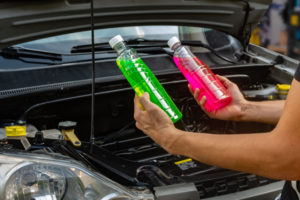Coolants, commonly referred to as antifreeze in concentrate format, are essential for vehicles throughout the entire year. However, their significance becomes even more prominent during the winter season, owing to several reasons:
- Freezing Prevention: During winter, due to wind chill factor and outside temperature dropping, water alone in a cooling system can freeze at or below the freezing point, causing significant damage to the engine and cooling system. Coolants and antifreeze lower the freezing point of the liquid to as low as -37°C, preventing it from solidifying and potentially damaging the engine.
- Temperature Regulation: Coolants play a crucial role in maintaining the optimal operating temperature of the engine. They help prevent the engine from overheating and freezing. Maintaining a consistent temperature is essential for engine efficiency and longevity. When the engine operates at its ideal temperature, it performs more efficiently, leading to better fuel economy and reduced emissions.
- Corrosion Protection: Coolants contain corrosion inhibitors that protect the various metal components within the engine’s cooling system from rust and corrosion.
- Heat Dissipation: Coolants aid in the dissipation of excess heat generated during engine operation, which is crucial in winter when the outside air temperature is low. They facilitate the transfer of heat from the engine to the radiator, where it can be dispersed.
Now that we know the importance of coolants and antifreeze, we must also understand the different types of coolants available in the market today:
- IAT (Inorganic Additive Technology (mineral)) – Silicates – Green or Blue
- OAT (Organic Acid Technology) – Organic Acids – Orange, Red or Yellow
- HOAT (Hybrid OAT, Phosphate-free) – NAP-free – Turquoise
- HOAT (Hybrid OAT) – Silicates and organic acids – Yellow
- Si-OAT (Silicated HOAT) – Silicates and organic acids – Purple or Pink
- P-HOAT (Phosphated HOAT) – Phosphates and organic acids – Blue or Pink
As evident in this compilation, there is a degree of overlap in the colours employed across different coolant varieties. It’s important to note that this list serves as a representation of the most widely used colours by leading manufacturers. Due to the incompatibility of many coolants, the consequences of selecting the wrong coolant or blending different types can lead to financial repercussions. The mixing of coolant types with distinct additives has the potential to dilute or compromise additive properties, diminishing the intended impact and protective capabilities. In some cases, it may even lead to a reaction resulting in a mixture that could obstruct the system. Hence, it is strongly advised to refer to your OEM manual before making a coolant selection for your vehicle.
If you are still unsure of the correct product type to use, consider the following guidelines:
- Consult your vehicle’s manual to determine the recommended coolant/antifreeze type, ensuring compliance with the vehicle’s warranty.
- Avoid being persuaded by price, especially by cheaper universal products claiming to meet all vehicle requirements. This is no longer possible as specific manufacturers have specific requirements and formulations for their cooling systems. Hence, the need for 6 different types on the market.
- Check the colour and look for similar colours, but remember, colour should only serve as a guide. It’s crucial to examine the label and the exact type of coolant, aligning it with the specifications outlined in your manual.
When in doubt, seek advice from a reliable stockist or supplier for accurate guidance on the required coolant type and recommendations for the best brand.
Since 1977, Finol has been a trusted advisor and supplier of Coolants & Antifreeze, committed to ensuring customers make informed choices about the right products. Our comprehensive Cooltemp range, available in 1L, 5L, 20L, 200L, and Bulk, caters to all leading makes and models. As a Finol customer, you can access free technical support and utilise our user-friendly WhichOil app at www.whichoil.ie for guidance. If you’re not yet a Finol customer and wish to engage with our sales and technical team, arrange a complimentary consultation by contacting 01 4555484.
